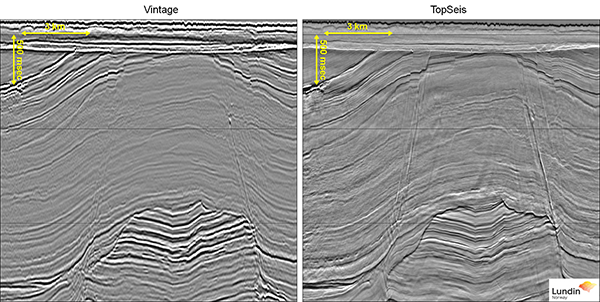CGG and Lundin Norway win NCS Exploration Innovation Prize 2019 for TopSeis
Paris, France | Jun 3, 2019
CGG and Lundin Norway AS have been awarded the NCS Exploration Innovation Prize 2019 for TopSeis™, a next-generation marine source-over-spread acquisition and imaging solution that delivers a step-change in imaging by providing massively increased near-offset coverage from a split spread with zero offsets.
The Exploration Innovation Prize is “awarded to a license group, company, team or person who, during the last couple of years, has given a courageous and innovative technological contribution in exploration for oil and gas on the Norwegian continental shelf. It is also required that the recipient has matured an exploration technology with high potential that can potentially lead to increased knowledge of the subsurface or future commercial oil and gas discoveries”.
TopSeis is the outcome of five years of close technical collaboration between CGG and Lundin Norway AS. This unique solution combines an innovative source-over-spread acquisition geometry with CGG’s advanced imaging technology to delineate shallow-to-intermediate depth targets, which are not resolved by conventional methods.
Results from the first full-scale 2,000 sq km commercial TopSeis survey acquired over the Loppa High in the Barents Sea in 2017 and processed in 2018 were excellent compared to conventional data in the area. CGG will also acquire a significantly larger 5,000 sq km multi-client TopSeis survey over the Greater Castberg area in the Barents Sea with TGS this summer with delivery of final data to clients in Q4 2020.
Sam Borman, SVP, Marine, CGG, said: “On behalf of CGG, I’d like to congratulate the whole TopSeis team from CGG and Lundin Norway whose innovative efforts have been rewarded with this well-deserved industry accolade. What started out as a novel acquisition and imaging concept for a specific exploration challenge in the Barents Sea has proven its superiority over conventional marine streamer acquisition and processing methods and shows great promise for helping to understand subsurface targets in other parts of the world.”

About CGG
CGG (www.cgg.com) is a global geoscience technology leader. Employing around 3,700 people worldwide, CGG provides a comprehensive range of data, products, services and solutions that support our clients to more efficiently and responsibly solve complex natural resource, environmental and infrastructure challenges. CGG is listed on the Euronext Paris SA (ISIN: 0013181864).